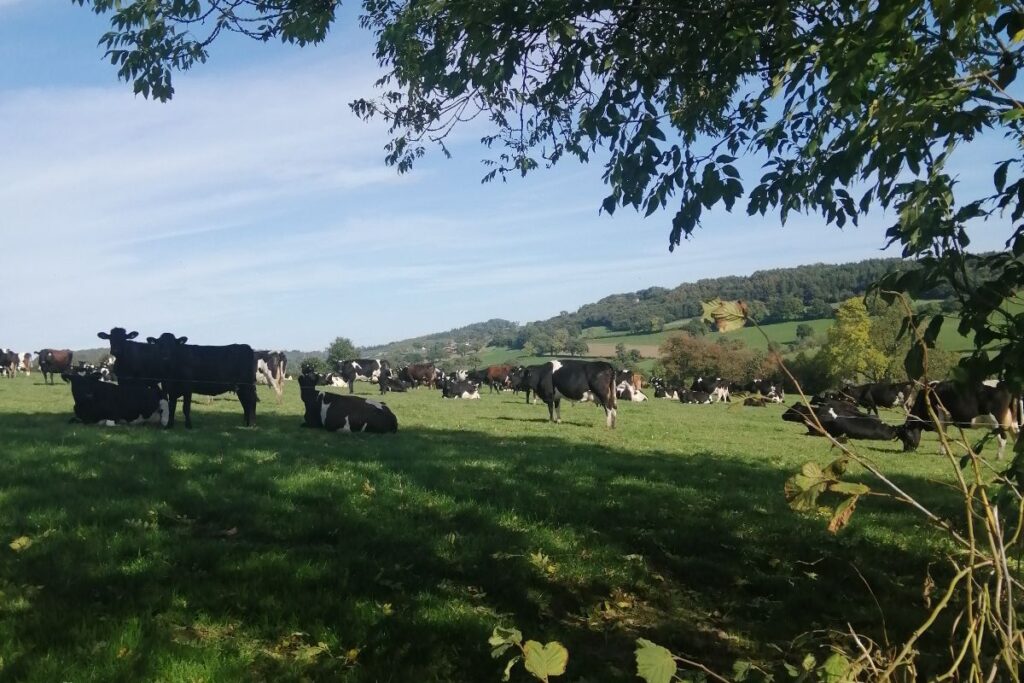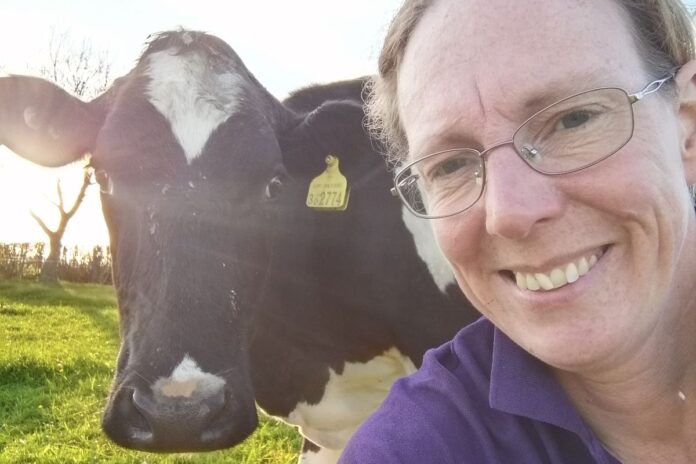That’s Farming editor, Catherina Cunnane, in conversation with Lorna Burdge, in this week’s dairy farming segment.
“I am a 40-year-old dairy farmer from East Devon in the UK. My husband (Jim) and I are tenant farmers with two tenancies on two neighbouring dairy farms.
I started milking cows at 19 and have had various careers linked with agriculture since graduating from university in 2004.
My husband has always been dairy farming, having been brought up on a family dairy farm and then becoming herds manager on larger dairy units.
In 2017, we were successful in our application for a farm tenancy and moved our family to Devon, and in 2019, we were also successful in our application for a second dairy farm with the same landlord.
Our business aim was to produce milk from grass on a low-input system. Block calving meant that we could keep our system simple, with batch feeding in the milking parlour and running the cows as a whole herd rather than groups.
We also decided to run flying herds, so that we could use all the grazing and forage production for the dairy herds.

Original farm
Our original farm is 86-acres, and we established an autumn block calving herd of 100 cows milked through a 16:16 parlour.
Initally, we purchased Holstein and Fresian-type cows; however, this herd has now moved to crossbred cows, with only a small number of the original Holsteins remaining.
When we took on the second farm, we employed a full-time herdsman (Reg) to continue the management of the autumn calving herd.
Second farm
On the second farm (170-acres), we established a 200-head spring calving herd, made up of Jersey and crossbred cows from the outset, as we wanted efficient grazers of lower bodyweight which could graze the farm for longer each year, with only a short housed period over winter.
This herd is managed by Jim and I. In 2020, we invested in a new 20:40 swing over parlour with MilkTech NZ ACRs (first UK installation).
This has significantly reduced the milking time for the spring calving herd, maximising their grazing time.
With taking on the second tenancy, we reviewed our milk contract and moved both units to Saputo Dairy UK, the makers of Cathedral City cheese, with both herds being on a solids contract – which the crossbreds and Jerseys are ideal for.
This has resulted in the Holsteins in the autumn-calving herd being replaced with crossbred cows over time to produce the quality of milk required for our milk buyer and maximise our milk price.

Labour availability
With there only being three of us across the two farms, having the split block works well from a labour perspective.
Jim and I are available to help during busier times of year on the autumn-calving farm (eg calving and service), and likewise, our herdsman, Reg, is able to help out when we are busy on the spring-calving farm.
It also gives us a relatively level milk profile and income throughout the year.
Genetics and heat detection
Both farms offer fantastic quality grazing for the cows, all are easily accessible, especially as we have invested in track infrastructure and improved the water infrastructure.
Both herds run as flying herds, using AI to British Blue for the first six weeks of service, and then we have two pedigree Hereford bulls who run with cows for a further 4-6 weeks.
Calves are all sold at approximately 3-4 weeks of age to beef farms for rearing.
The spring-calving herd’s 6-week in-calf rate is 75%, and the autumn-calving herd’s 6-week in-calf rate stands at 79%.
We use Estrotect breeding indicator patches for heat detection. We sticker all the cows four weeks before the start of service to check everyone is cycling and then restick weekly during the AI period.
AI is carried out by a local company that supplies us with easy-calving British Blue semen.
Autumn-calving milk production stands at 7,000L, 4.6% butterfat, and 3.6% protein from 1.5t on concentrates.
Meanwhile, spring-calving milk production reports at 5,000L, 4.7% butterfat and 3.7% protein from 1.1t of concentrates
Grazing
With grazing being at the core for both of our dairy herds, weekly grass walks are carried out on both farms during the grazing season by Jim and Reg.
The cows are paddock/strip grazed, with back fences to protect regrowth.
For the spring-calving herd, we grow a break crop of stubble turnips to supplement their grazing later in the summer.
For the autumn-calving herd, we lock up a field for standing hay which is strip grazed during their dry period.
All fieldwork is carried out by a local family contractors business, with fields for silage being incorporated into the grazing platform later in the season.
Using external contractors enables the three of us to dedicate all our working time to the cows and has meant that we have not had to invest heavily in machinery. Both farms have cubicle housing for the winter months.

Herdwatch
The main tech we use on-farm is the Herdwatch app for all of our record-keeping.
We have been with Herdwatch since 2018 and have found it to be a quick and easy system to use for all our movements, medicines and general cow health records.
This means less of my time tied up with paperwork as I can record information live while working, saving me hours each week.
The benefits of having all the cow records on my phone have been critical time and time again, e.g., during PD sessions, during calving for drafting out the close-to-calving cows, recording all our service information and quickly registering all newborn calves.
In 2022, Herdwatch nominated us for Dairy Farmers of the Year at the British Farming Awards, with us being shortlisted in the final.
This came as a complete surprise and was an amazing process to be part of.
Farmer Time
In addition to farming full-time, I also spend time most weeks talking to school children about food and farming via a Farmer Time video link.
I believe this is time very well spent as for some of the children, the only time they have seen a cow is in a book.
We discuss what is happening on the farms during the seasons, and they get to see the cows and calves up close.
I also send them a milking video so they can see what happens in the milking parlour and we talk about how our milk gets from the farm to the shops. Most importantly, the children get their questions answered by a farmer first-hand.
Future
We are aiming to continue to tweak our farms, to improve efficiency, whether this is by better grassland management, better replacement selection etc., to maximise milk price and optimise our low-input system.
We have no desire to get bogged down with too much technology, which will probably have little overall benefit to our business long term.
With three young children, we are always looking ahead and thinking about where we would like to see ourselves in 5, 10, and 15 years times and whether it is something that our children will want to have an involvement in or, if they will want to choose a different career path.
Reflection
When we first took on our tenancy, our aim was to produce milk from grass on a low-input, low-cost, simple system, which would enable Jim and I to work side by side and give plenty of free time to enjoy with our young family.
We feel that we have achieved that aim, and even though our business has expanded, our aim to produce milk from grazing cows remains at the core of everything we do.
We look to continue with this type of system as it is working well for us with low labour and machinery requirements.
In light of this, we believe we will be more resilient against potential market volatility in the future.”
To share your story, email – [email protected]





